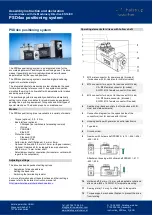
10
7 NP 72 en
cam plate at the mark. Tighten the locking wheel (30)
and the screw (31).
3. Switch on the supply pressure (S) and the input signal
(IN).
4. Set the input signal at the closed limit of the valve so
that it is 2 % i.e. 0.02 bar (0.2 psi) higher or lower than
the limit value, e.g. 0.2 + 0.02 = 0.22 bar (3 + 0.2 = 3.2 psi)
or 1.0 - 0.02 = 0.98 bar (15 - 0.2 = 14.8 psi). Loosen the
screw (56). Turn the zero adjustment screw (67) so that
the actuator comes slowly to the closed limit. Tighten
the screw (56) always after the zero adjustment. The
valve should open slightly with a 4 % change in signal,
that is 0.03 bar (0.5 psi), e.g. 0.2 + 0.03 = 0.23 bar (3 + 0.5
= 3.5 psi) or 1.0 - 0.03 = 0.97 bar (15 - 0.5 = 14.5 psi). See
Figure 9.
5. Set the input signal to the other limit value. The valve
should be entirely open at 100 %, i.e. 1.0 bar (15 psi) or
0.2 bar (3 psi). The valve should start to operate to
closed direction at 98 %, i.e. 0.98 bar (14.0 psi) or 0.22
bar (3.2 psi).
The range, i.e. turning angle, changes when the effective
lenght of the spring (60) is increased or decreased by turn-
ing the range adjustment nut (60.3). See Fig. 9.
6. The zero and range adjustments affect each other, so
stages 4 and 5 must be repeated a few times.
7. Screw on the pointer (32) into place so that the yellow
line is in the direction of the valve closing member.
Tighten the screw (57).
7
SPLIT-RANGE ADJUSTMENT
In principle, split range adjustments are made in the same
manner as for a normal signal range. Select a split range,
20-60 kPag / 0.2–0.6 barg / 3–9 psig or 60-100 kPag /
0.6–1.0 barn / 9–15 psig, from the cam plate. See Figure 6.
8
MAINTENANCE
Regular maintenance is not necessary.
The need for maintenance depends on the quality of the
instrument air. See also Section 2.5.
If there is need for servicing proceed according to the fol-
lowing sections.
8.1
Supply air filter
The supply air filter (50) is located in the supply air connec-
tion (S); the filter can be removed for cleaning.
8.2
Pilot valve
Remove the pilot valve (44) by first loosening the nuts (49),
and then by lifting off the protective plate (48), the change-
over piece (46) and the gasket (45).
Table 3
Dead angle in degrees
Valve
size
Valve series
MBV
QMBV
1)
MBV
QMBV
2)
D
3)
T5,
QT5
QXT5
T25,
QT25
QXT25
R,
QR
mm
mm
Dead angle in degrees
25
1
12.5
-
-
23.0
17.5
-
-
14
40
1 1/2
11.0
-
-
22.0
11.0
-
-
11
50
2
9.0
8.0
12.0
22.0
11.0
16.0
7.0
15
65
2 1/2
8.0
-
-
-
-
-
-
11
80
3
9.0
7.0
11.0
16.0
7.0
15.0
8.0
8
100
4
9.0
7.0
11.0
15.0
7.5
14.5
8.0
7
125
5
11.0
-
-
-
-
11.0
6.0
7
150
6
9.0
7.0
10.5
14.5
8.0
12.0
7
200
8
8.0
6.5
7.5
11.0
6.0
8.5
6
250
10
8.0
6.5
7.0
12.0
8.5
6
300
12
7.0
5.5
5.5
8.5
7.0
5
350
14
5.4
5.5
-
4
400
16
4.5
5.0
8.5 (14")
4
450
18
5.0
7.0 (16")
500
20
5.5
600
24
5.0
650
26
6.0
700
28
6.0
750
30
5.5
800
32
-
900
36
4.5
1) Seat supported 2) Trunnion 3) S/G seat
Table 4
Shift caused by dead angle, mm/inch
α
0
Segment C
Segment E
Segment D
20°
*)
6.1/0.24
8.1/0.31
19°
*)
5.8/0.22
7.7/0.30
18°
*)
5.5/0.21
7.3/0.28
17°
*)
5.2/0.20
6.9/0.27
16°
*)
4.9/0.19
6.5/0.25
15°
3.1/0.12
4.6/0.18
6.1/0.24
14°
2.9/0.11
4.3/0.16
5.7/0.22
13°
2.7/0.10
4.0/0.15
5.3/0.20
12°
2.5/0.09
3.7/0.14
4.9/0.19
11°
2.3/0.09
3.4/0.13
4.5/0.17
10°
2.1/0.08
3.1/0.12
4.1/0.16
9°
1.9/0.07
2.8/0.11
3.7/0.14
8°
1.7/0.06
2.5/0.09
3.3/0.12
7°
1.5/0.05
2.2/0.08
2.9/0.11
6°
1.3/0.05
1.9/0.07
2.5/0.09
5°
1.1/0.04
1.6/0.06
2.1/0.08
4°
0.9/0.03
1.3/0.05
1.7/0.06
*) Segment C:
α
0
max. 15°
CAUTION:
Do not dismantle a pressurized positioner!
NOTE:
Ensure the cleanness of the air piping.
Summary of Contents for NB723
Page 19: ...7 NP 72 en 19 ...























